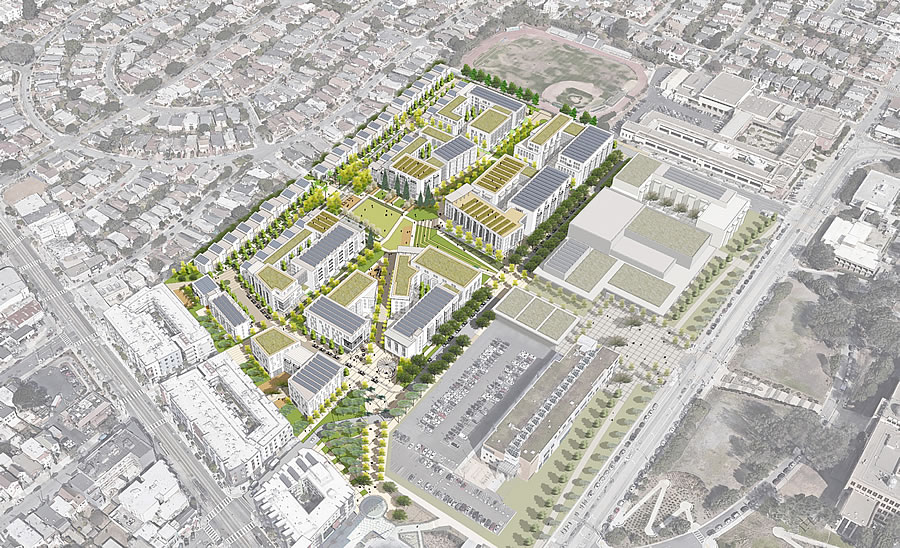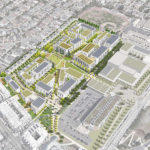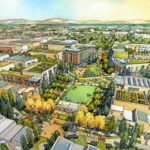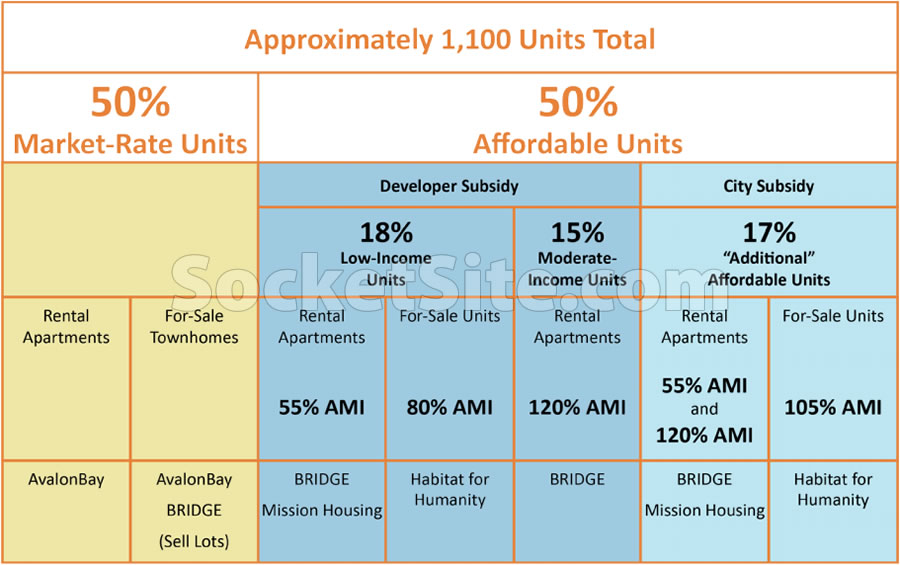According to a draft Fiscal Responsibility report for the massive Balboa Reservoir project, the projected $560 million development, a total which doesn’t include the price of the land or community benefits which have yet to be negotiated, could break ground “as early as 2021,” which is right in line with our original projection.
As such, the first wave of the development’s proposed 1,100-ish residential units could be ready for occupancy as early as 2023 with a second wave following two years later, “depending on market conditions.”
And of the 1,100-ish units, fifty (50) percent are slated to be offered at below market rates (i.e., “affordable”) to households with income limits ranging from 55 to 120 percent of the area median as broken down below:
The current Area Median Income (AMI) in San Francisco is around $81,000 for an individual and $92,000 for a household of two.
And once again, the current plans include off-street parking for over 1,000 cars with 500 spaces within a shared public garage, adjacent to CCSF’s proposed Performing Arts Center project.
We’ll keep you posted and plugged-in.





Looking forward to the CAC meeting on Monday
Where are you getting the figure for 1000 off street parking spaces? The Development Overview says .5 spaces per unit.
While Avalon’s winning proposal included up to 1,260 parking spaces, the draft responsibility report was based on 1,010 (and we actually wrote “parking for over 1,000 cars” above).
Wow, a minimum of 3 years of negotiations until the start of construction for a no-brainer project like this. SF bureaucracy plays truly in its own league.
I take issue with “massive.” It’s limited to six stories, stepping down to two. This is a rare opportunity for greenfield development near a junction of four rail lines, in a city with a housing shortage, and the downsized current plans are appalling. SFHAC is still advocating for the number of homes to be increased to 2500ish. That’s still too few, but hopefully we’ll at least get that many in the end.
This city has no idea what massive means. 4-6 stories seems to fit that definition all to easily here. I was recently in Singapore, where ‘massive’ housing construction was being build at too many transportation nodes to count, which consisted of 30-40-50 story condo towers. All you needed to do is look for the clusters of buildings going up, in any direction, to know which direction to walk to get on one of the best transportation systems in the world. Talk about a city planning for the future. If you look up our building/construction vocabulary in a dictionary I think you would be completely confused as to how those definitions come anywhere close to what is being described.
Thank you! If nothing else, we should at least be encouraging some high-rises right around (1/4 mile radius) rail hubs like Glen Park and Balboa Park stations. I hope as millennial Californians start paying attention and voting, ideas like that won’t seem radical anymore, and we can end the bias toward keeping everything looking the way it does now (transit and affordability be damned).
Perhaps the word “massive” has more to do with the size of the 17-acre site, which is one of the largest underdeveloped sites in San Francisco, versus the density or height of the development as proposed.
Building a 1.1 million square foot duplex upon the site (the rough square footage of residential space as proposed) would be a rather massive development despite a theoretical density of 0.1 units per acre.
But speaking of density in the absolute, the development as proposed would run around 94,000 people per square mile, which is over 3x the average density of San Francisco and roughly 25 percent denser than Manhattan overall.
Fair – the site is massive, and it’s a crime that we’re only going to allow suburban density on it.
[Editor’s Note: “…the development as proposed would run around 94,000 people per square mile, which is over 3x the average density of San Francisco and roughly 25 percent denser than Manhattan overall.”]
And if we were rebuilding the whole rest of the city at Manhattan density too, I might be tempted to agree there was something remotely relevant about that comparison.
…nothing is ever good enough for anyone, so the bitching and moaning continues while nothing gets done.
On the contrary, I’ll bitch and moan WHILE getting things done. I’m willing to support the project as is over no project. It’s just important to call out the short-sighted planning that prevented it from being much better, so the City is held accountable and will hopefully do better in supporting the maximum reasonable amount of homes in future plans.
SFHAC should also pay for the transit, public library, schools and infrastructure in general. They want lots of cars in essence (units) but forget how to pay for gas maintenance upkeep and roads, they ignore half the equation.
I’m all for the current scheme but feel transit linkage must improve with a high line and direct pedestrian bike connection to balboa park station along CCSF’s southern edge possibly with a joint garage on the CCSF eastern edge.
there is way too much parking in this plan. this is right on the BART line
no, it’s one km from BART line and it’s a nasty dodgy walk at that. It is ridiculous to pretend all commuting students live on a BART line, that they don’t have kids and jobs and academic programs, or that BART is affordable. BART is not a shuttle bus and was never intended to serve every community, and it does not even come close. Faculty cannot shlep 30 pounds of class materials on BART then walk walk walk. Cars DO suck, but so does car shaming. Muni is a joke. HELP people do better or this will backfire hugely.
This thing reads as a typical suburban gated community. Puts traffic on the surrounding neighbor streets – doesn’t allow any traffic from the neighbors through the developers property. ?
All for more housing though. No reason the City should have sat on the site as long as it did.
The site has major constraints.
To the west, the proto-suburb of Westwood Park doesn’t have a lot of through streets, nor even straight streets. The Westwood Park Neighborhood Association vigorously opposes all traffic coming from the site, even pedestrian traffic, and they have the lawyers to underline their opposition.
To the north, Riordan High School has a football field that they would have to give up to allow through traffic. We don’t seem especially interested in eminent domaining that.
The only possible driveways are south and east. And neither goes straight to anything important; east has to cross the CCSF parking lot to turn onto Phelan Ave, and south has to cross the Whole Foods loading dock to turn onto Ocean Ave.
There are 3 major differences from a suburban cul-de-sac:
1) Pedestrian and bike paths in every direction, in defiance of the Westwood Park Neighborhood Association.
2) A lot of transit lines at a corner of the site.
3) A lot more height and density.
Wow 3 years of planning . San Francisco is only advanced in virtual reality .
3 years is far too long for this. It should not take anywhere this long.
A class of UCB architecture students could do just as well in a semester long class.
The City is opening about 5,000 new housing units a year. We have 385,000 existing housing units – so adding 1% to the housing stock per year? And that’s not counting for units getting demolished?
SF housing supply will only get tighter with Planning’s lack of urgency.
Even if we bought your premise, which we don’t, keep in mind that at the end of said semester, said class would still need to complete a detailed environmental study and review based on state law; rezone the site (which is currently designated for “Public” use and development of no more than 40 feet in height); successfully negotiate a development agreement; and then secure approvals from the City in order to proceed as proposed.
The list of tasks is all too true.
Our process needs major reform.
SF is opening 3K plus units/year of new housing. It is only in recent years it has exceeded 3K and IIRC that number will start dropping in a few years. 5K units/year – you are thinking of eattle.
Only about 1,000 units of housing? *cries
If I wanted to live in Singapore, I’d move there. This colossal dense building is destroying character, creating huge inflation in rents and prices, and driving working class folks out of town. Ethnic cleansing. Like in the sixties in the Fillmore, only without eminent domain.
CCSF students are desperate for parking – they have kids and jobs and commutes. BART does not serve them in any way. I worked on Ocean campus since 2002, this is fact, not my opinion. We can enable their success, or have more ultra rich moving in.
@Aimee – please explain how dense building creates huge inflation in rents and how a project with 50% affordable housing is serving the ultra rich.
Might as well ask @Aimee to explain the ethnic cleansing claim as well considering there is no one living on the site currently.